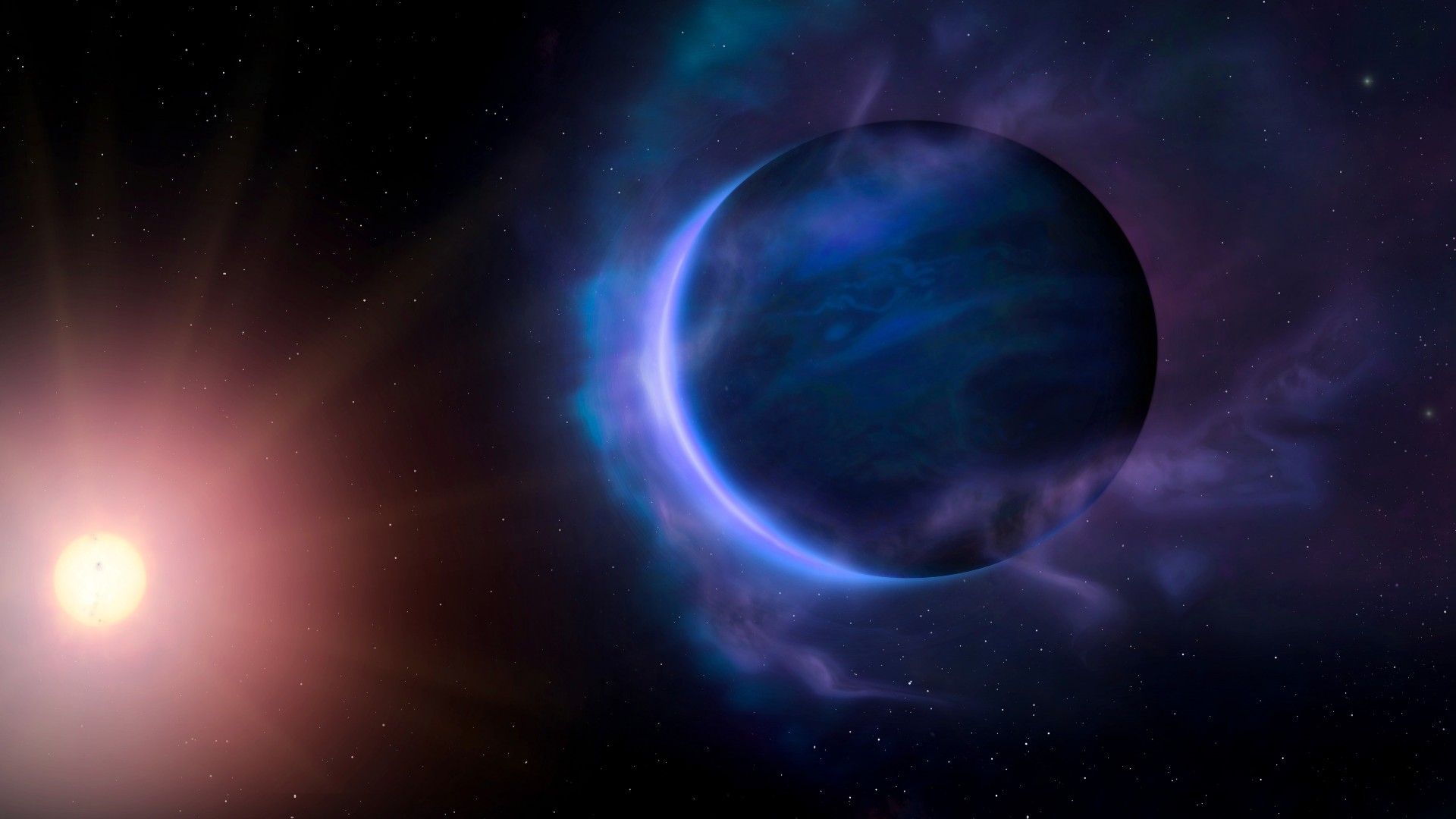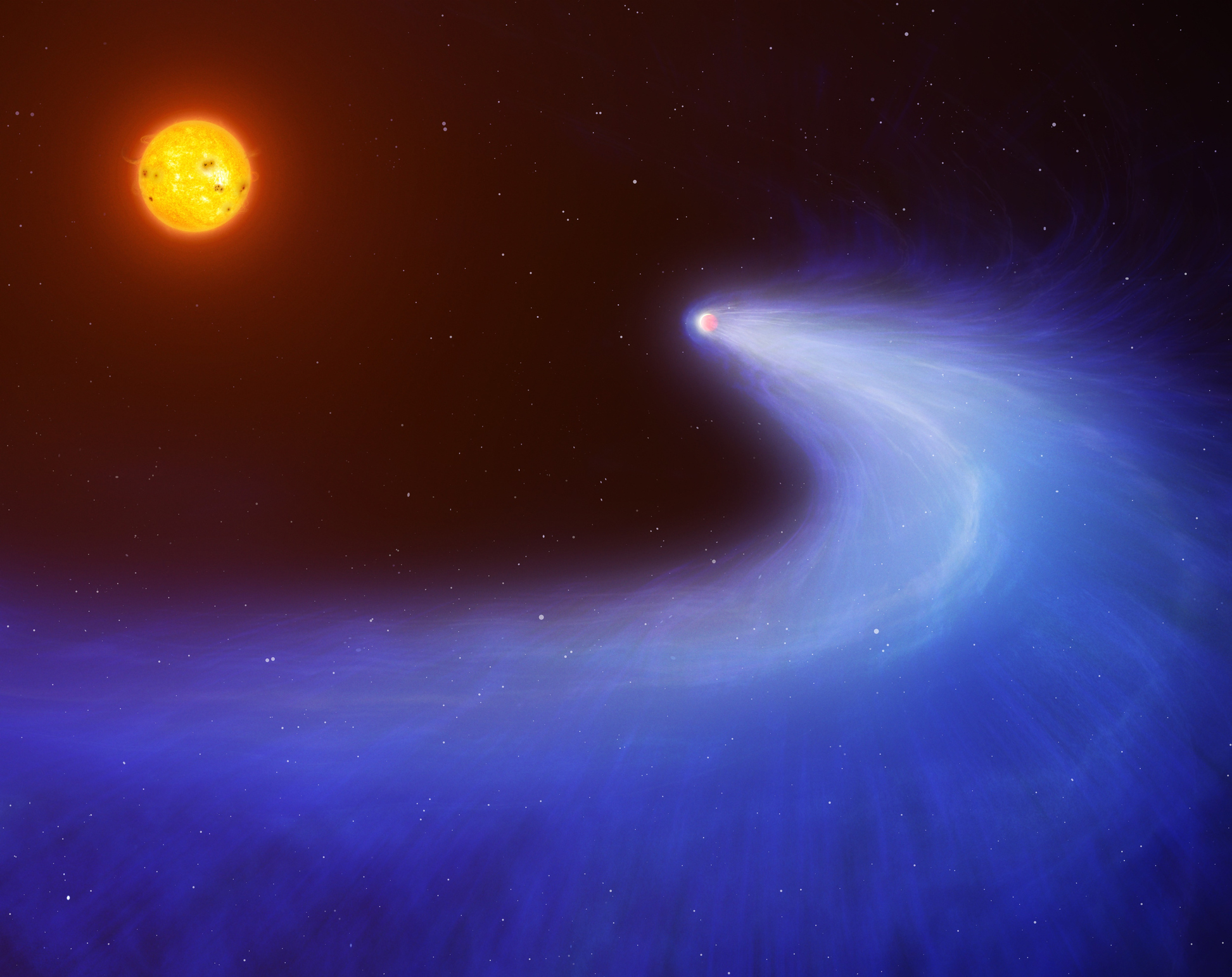Puffy helium planets could explain exoplanet size mystery
The fate of Neptune-like worlds that migrate close to their star is to be whittled away by stellar radiation.

Helium could make up almost half the mass of the atmosphere of giant exoplanets that have migrated close to their star, explaining why there is a mysterious size gap in the scale of these worlds.
Over 5,200 exoplanets have now been confirmed, and many of these are larger worlds that orbit close to their star, in some cases with orbital periods that last just a few days. However, transit observations first by NASA's Kepler Space Telescope and now by TESS, the Transiting Exoplanet Survey Satellite, have found a puzzling dearth of planets with radii between 1.4 and 2.4 times that of Earth. Astronomers call this the 'radius valley' and although it seems to be telling us something fundamental about the nature, formation and evolution of planets, scientists have yet to ascertain what that something is.
Now, a new take on the radius valley from a team led by PhD student Isaac Malsky of the University of Michigan and Leslie Rogers of the University of Chicago suggests that it could signal an increasing abundance of helium gas in the atmosphere of worlds 2.4 times larger than Earth. Worlds of this scale are often described as mini-Neptunes, and if they have a rocky core, it's deep beneath a thick swathe of atmosphere.
Related: Exoplanets: Worlds Beyond Our Solar System
Early in their lives, while still forming within the protoplanetary disk of gas and dust, planets that formed farther out from their star can migrate inwards. The closer they move to their star, the more they are impacted by the star's heat and radiation, a mix of stellar winds and flares that can gradually remove an atmosphere from a planet in the firing line. As this happens, a planet can grow a comet-like tail as gas is stripped away to leave a bare, rocky core.
The atmosphere of such worlds is made largely from hydrogen and helium. Jupiter, in our solar system, is a good example of this atmospheric make-up, being 90% hydrogen and 10% helium. However, hydrogen is lighter than helium and can escape into space more easily.
Malsky and Roger's team designed a computer model that simulated a whopping 70,000 exoplanets of different sizes, orbiting different stars and at different temperatures, to see what effect the heat from their nearby star would have on their atmosphere. They found that indeed hydrogen was removed quicker than helium, resulting in the abundance of hydrogen decreasing relative to the amount of helium present.
Get the Space.com Newsletter
Breaking space news, the latest updates on rocket launches, skywatching events and more!
In the most extreme circumstances some of the planets that they simulated had atmospheres that were over 40% helium by mass. These helium worlds would occupy the bottom end of the higher size range, around 2.4x larger than Earth by radius — whether they have an atmosphere rich in hydrogen or helium, the heat from their nearby star would still cause the atmosphere to become bloated and expand, increasing the radius of the planet.

Smaller worlds on the other side of the radius valley, with radii of 1.4 times that of Earth or less, would have lost all their hydrogen and helium and would have no significant atmosphere, limiting their radius to just that of their rocky core. It is possible that having lost their primordial atmosphere, these planets could then outgas a new, thinner atmosphere similar to Earth's. But if they are much closer to their star than Earth is to the sun, then they would face a battle to hold onto this new atmosphere too.
"There are so many weird and wonderful kinds of exoplanets out there, and this finding not only adds a new kind but may have implications for understanding the evolution and formation of planets in general," said Rogers in a statement. "Getting a better understanding of this population could tell us a lot about the origins and evolution of sub-Neptune-size planets, which are clearly a common outcome of the planet-formation process."
These new findings support earlier research that posits that not only do planets lose their thick primordial atmosphere as they migrate closer to their star, this inward migration of multiple planets in a system could lock worlds into gravitationally resonant chains, like 'peas in a pod.'
Helium, despite being the second most common element in the universe, was only detected on an exoplanet for the first time in 2018. However, with the launch of NASA's James Webb Space Telescope (JWST), astronomers have a new instrument in their toolkit for detecting atmosphere gases on exoplanets. If the radius valley is truly the result of planets wandering too close to their star and having their atmosphere shock-heated into space, then JWST could provide observational evidence by conducting spectroscopy of hot planets with radii of about 2.4 times that of Earth to determine the abundance of helium in their atmosphere.
The results were published in Nature Astronomy.
Follow Keith Cooper on Twitter @21stCenturySETI. Follow us on Twitter @Spacedotcom and on Facebook.
Join our Space Forums to keep talking space on the latest missions, night sky and more! And if you have a news tip, correction or comment, let us know at: community@space.com.

Keith Cooper is a freelance science journalist and editor in the United Kingdom, and has a degree in physics and astrophysics from the University of Manchester. He's the author of "The Contact Paradox: Challenging Our Assumptions in the Search for Extraterrestrial Intelligence" (Bloomsbury Sigma, 2020) and has written articles on astronomy, space, physics and astrobiology for a multitude of magazines and websites.
-
rod "Table 1 | All planets in the Mp–Rp–Fp parameter space for which we predict helium enhancement after 10 Gyr of fractionated mass loss"Reply
This table in the cited reference contains 15 exoplanets that look like fun to examine.
Using the exoplanet.eu site I found 1177 listed with radii 1.5 to 2.5 earth radii size. 1333 exoplanets turned up at the NASA exoplanet archive site for these radii criteria. Plenty to look at :) -
rod I went and back and reviewed the exoplanet.eu site. radii between 0 and 2.5 earth radii selected 1973 exoplanets. The min radii = 0.0000224 earth radii, max = 2.4996070 earth radii. Mean = 1.6515071 earth radii, 1sigma = 0.4916375 earth radii. Not hard to see where the majority plots for size or radii reported for this SQL query. The semimajor axis min = 0.0034000 au and max = 1.9800000 au, mean = 0.0989760 au, 1sigma = 0.1162790 au. Most of these exoplanets are orbiting much closer to their parent stars and many with larger radii sizes than what is in our solar system from Mercury out to Mars. Where we live today on planet Earth and our solar system configuration (especially the terrestrial planets) is radically different than many exoplanets documented today.Reply









